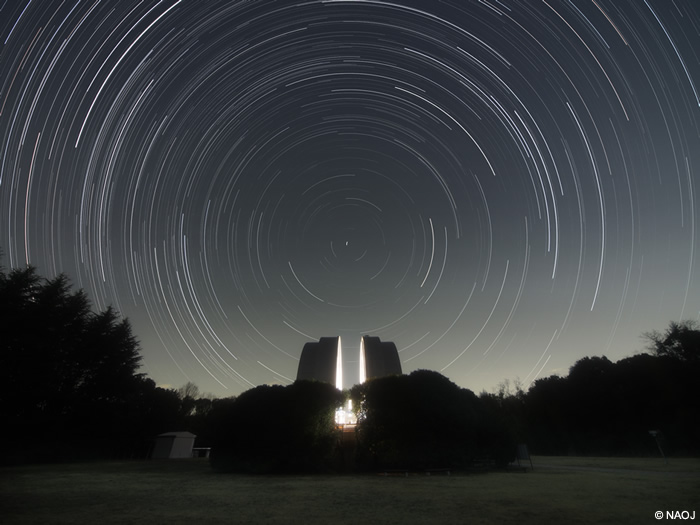Detailing the Rotation of Celestial Objects
Night Scape Photograph・

| Date | Winter 2013 |
|---|---|
| Location | NAOJ Mitaka Campus |
| Photographer | Yutaka Iijima |
| Credit | National Astronomical Observatory of Japan |
| Terms of Use | This image can be used without permission for research presentations, conferences, and school classes. In other cases, it cannot be used without prior permission. If you would like to use it, please fill out an application. In the case of commercial use, a photograph usage fee might need to be negotiated with the photographer, Mr. Yutaka Iijima. |
Stars of the daily revolving heavens. Under them, the Automatic Photoelectric Meridian Circle in Mitaka Campus waits quietly on the stars’ transits. The most important basis for astronomy is accurate star charts. A meridian circle is a special type of telescope which turns along a north-south line following the meridian (line of longitude). By exactly observing the time a celestial body crosses the meridian, it is possible to determine its coordinates (right ascension and declination.) The Automatic Photoelectric Meridian Circle which previously played an important role in precise celestial object coordinate observations is now open to the public as the Astronomical Instruments Museum.
Observations to determine time and celestial coordinates have been conducted since the time of the Tenmonkata (Official Astronomer) for the Bakufu, the Shogun led military government. Many meridian circles imported from the West after the Meiji Restoration still remain in Mitaka Campus. You feel connected to the roots of astronomy and understand the progress of observations.
Built in 1982, the Automatic Photoelectric Meridian Circle contributed to astrometry by investigating the locations and movements of celestial objects. Before that, observations had been conducted by eye using a photoelectric micrometer. The Automatic Photoelectric Meridian Circle greatly improved both observational efficiency and positional accuracy. Its results have been compiled in many star tables and have played a role in a variety of astronomy research, such as resolving the rotation of the Milky Way Galaxy and the motions of Solar System objects. Later, the leading role passed to new methods of precision astrometry. In the 2010’s the NAOJ is promoting VLBI (Very Long Baseline Interferometry) observations linking antennas at four locations in Japan being conducted by the VERA project and also promoting the next generation JASMINE (Japan Astrometry Satellite Mission for INfrared Exploration) project to conduct observations from outer space. Based on these high precision observations, we are striving for “star chart development.”
Author: Seiichiro Naito (Public Relations Center, NAOJ)